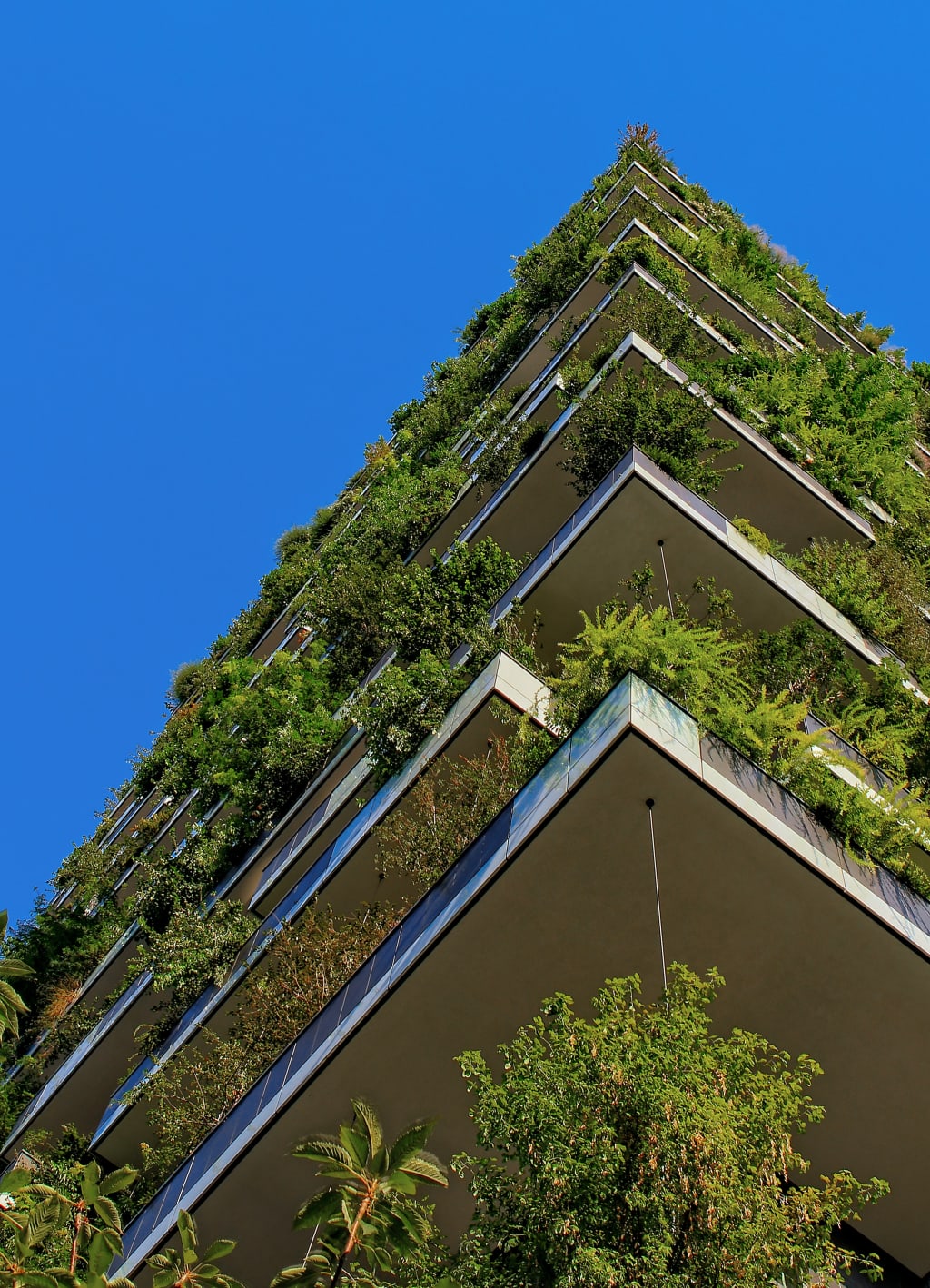Sustainable Architecture
To Increase awareness about sustainability & how can we convert ourselves from concrete jungle to sustainable architecture

In today's world, the concrete jungle dominates our cities, with towering buildings and expansive pavement covering vast swathes of land. However, this reliance on concrete comes at a cost, with negative impacts on the environment, public health, and economic development. In response to these challenges, architects and builders are increasingly turning towards sustainable architecture, using natural and recycled materials, green roofs and walls, and energy-efficient systems to create buildings and communities that are more environmentally friendly, economically viable, and healthier for residents. This story explores the principles and practices of sustainable architecture, highlighting its potential to create a more resilient, livable future for all.
Sustainable Architecture is a practice that seeks to minimize the negative impact of buildings on the environment and human health, while maximizing their positive impact. This can be achieved through various means, such as using renewable energy sources, incorporating green spaces, and utilizing materials that have a low carbon footprint.
In order to divert ourselves from the concrete jungle into a sustainable architectural environment, there are several steps that can be taken. One important step is to prioritize the use of renewable energy sources, such as solar or wind power, for the energy needs of buildings. Additionally, incorporating green spaces such as parks and gardens can help to improve air quality and reduce the urban heat island effect. Finally, using sustainable building materials such as recycled steel and reclaimed wood can help to reduce the environmental impact of construction.
Overall, by embracing sustainable architecture practices, we can create buildings and cities that are not only better for the environment, but also healthier and more livable for their occupants.
To further promote sustainable architecture, it is important to consider the entire lifecycle of a building, from its design and construction to its use and eventual demolition. This means designing buildings that are flexible and adaptable to changing needs and technologies, as well as incorporating strategies for minimizing waste and conserving resources during both construction and operation.
Another important aspect of sustainable architecture is community engagement and collaboration. By involving local communities in the design and construction process, we can ensure that buildings meet the specific needs and desires of the people who will be using them. Additionally, by creating spaces that promote social interaction and community engagement, we can help to foster a sense of belonging and connection within our cities and neighborhoods.
Ultimately, the shift towards sustainable architecture requires a collective effort from architects, builders, policymakers, and individuals alike. By working together to prioritize the health of our planet and our communities, we can create a more sustainable, livable future for ourselves and future generations.
In addition to the aforementioned steps, there are several other strategies that can be employed to promote sustainable architecture. One such strategy is to design buildings that are energy-efficient and reduce reliance on fossil fuels. This can be achieved through the use of high-performance insulation, energy-efficient lighting and appliances, and passive heating and cooling systems.
Another strategy is to incorporate water-efficient features such as rainwater harvesting and greywater recycling systems, which can help to reduce water consumption and minimize the impact of buildings on local water resources.
Finally, the use of sustainable transportation and land-use strategies can help to reduce the environmental impact of our buildings and cities. This includes promoting walking, cycling, and public transportation, as well as designing communities that are compact, walkable, and mixed-use.
Overall, the key to creating a sustainable architectural environment is to prioritize the health of both people and the planet, and to embrace a holistic approach that considers the environmental, social, and economic impacts of our buildings and cities. By doing so, we can create a more resilient and sustainable future for all.
Concrete Jungle:
The term "concrete jungle" refers to the proliferation of urban areas that are dominated by concrete and other artificial materials, often at the expense of green spaces and natural environments. While these areas may be necessary to accommodate the growing populations of our cities, they can have a number of negative impacts on human health and the environment.
One of the main ways that the concrete jungle can be harmful is through the urban heat island effect. This occurs when the abundance of concrete and other heat-absorbing materials causes urban areas to become significantly warmer than surrounding rural areas. This can lead to a number of health problems, including heat exhaustion and respiratory issues, particularly for vulnerable populations such as the elderly and those with respiratory conditions.
In addition to the heat island effect, the concrete jungle can also have a negative impact on air quality. Buildings and vehicles in urban areas release pollutants such as particulate matter, nitrogen oxides, and volatile organic compounds, which can contribute to respiratory problems and other health issues.
Finally, the concrete jungle can also have a negative impact on the natural environment. The destruction of natural habitats to make way for buildings and infrastructure can lead to a loss of biodiversity, while the proliferation of impervious surfaces such as concrete and asphalt can contribute to flooding and other environmental problems.
Overall, while urban areas are necessary to accommodate the growing populations of our cities, it is important to balance the need for development with the need to prioritize human health and the environment. By incorporating sustainable architecture practices, we can create buildings and cities that are healthier, more livable, and more sustainable for all.
Materials to promote Sustainable Architecture!
There are many different types of materials and elements that can be used to promote sustainable architecture and reduce the impact of the concrete jungle. Here are some examples:
1. Natural and recycled materials: Materials such as wood, bamboo, and natural stone can be used to create more sustainable buildings. Additionally, recycled materials such as reclaimed wood, recycled steel, and recycled plastic can be used to reduce waste and minimize the environmental impact of construction.
2. Green roofs and walls: Green roofs and walls are vegetated surfaces that can be added to buildings to improve air quality, reduce the urban heat island effect, and provide habitats for wildlife. These features can also help to reduce stormwater runoff and provide insulation, which can reduce energy costs.
3. Renewable energy sources: Incorporating renewable energy sources such as solar panels, wind turbines, and geothermal systems can help to reduce the energy consumption of buildings and minimize reliance on fossil fuels.
4. Water-efficient features: Strategies such as rainwater harvesting, greywater recycling, and low-flow fixtures can be used to reduce water consumption and minimize the impact of buildings on local water resources.
5. Passive heating and cooling systems: Passive heating and cooling systems such as natural ventilation, shading devices, and thermal mass can be used to regulate temperature and reduce the need for energy-intensive heating and cooling systems.
6. Pedestrian and bike-friendly design: By prioritizing pedestrian and bike-friendly design, cities can encourage alternative forms of transportation and reduce reliance on cars, which can help to reduce traffic congestion and air pollution.
7. Passive solar design: Passive solar design involves orienting buildings and windows to maximize natural light and heat from the sun, which can help to reduce the need for artificial lighting and heating.
8. Smart home technology: Smart home technology can be used to monitor and control energy use, water consumption, and other aspects of building performance. This can help to optimize efficiency and reduce waste.
9. Low-impact building techniques: Techniques such as modular construction, prefabrication, and off-site fabrication can be used to reduce waste and minimize the environmental impact of construction.
10. Biomimicry: Biomimicry involves using nature as a model for sustainable design. By studying the way that natural systems and processes work, architects and designers can create buildings and systems that are more efficient and sustainable.
11. Urban agriculture: Urban agriculture involves growing food in urban environments, which can help to improve food security, reduce the environmental impact of food production and transportation, and provide green spaces in urban areas.
12. Natural ventilation: Natural ventilation involves using natural air movement to regulate indoor temperatures and improve air quality. This can help to reduce energy use and improve the health and comfort of building occupants.
13. Biophilic design: Biophilic design involves incorporating natural elements such as plants, water features, and natural light into building design. This can help to reduce stress, improve productivity, and enhance overall well-being.
14. Low-emitting materials: Low-emitting materials such as low-VOC paint, formaldehyde-free insulation, and non-toxic adhesives can be used to minimize indoor air pollution and improve indoor air quality.
15. Net-zero energy buildings: Net-zero energy buildings are buildings that produce as much energy as they consume. By incorporating renewable energy sources and optimizing energy efficiency, net-zero energy buildings can help to reduce carbon emissions and promote sustainable living.
16. Adaptive reuse: Adaptive reuse involves repurposing existing buildings and infrastructure for new uses. By reusing existing structures rather than building new ones, we can minimize waste, reduce energy consumption, and preserve historic buildings and neighborhoods.
17. Water-sensitive urban design: Water-sensitive urban design involves designing urban areas to manage water sustainably, using techniques such as permeable pavements, green roofs, and rain gardens. This can help to reduce the impact of flooding, improve water quality, and enhance the overall resilience of urban areas
CONCLUSION:
In conclusion, sustainable architecture offers a promising solution to the negative impacts of the concrete jungle. By using natural and recycled materials, green roofs and walls, renewable energy sources, water-efficient features, and passive heating and cooling systems, we can create buildings that are more energy-efficient, cost-effective, and healthier for both people and the environment. Additionally, by embracing smart home technology, biomimicry, urban agriculture, and water-sensitive urban design, we can create sustainable communities that prioritize the health and well-being of residents. By working together to promote sustainable architecture, we can create a more resilient, livable future for ourselves and future generations.
1. Sustainable architecture is crucial for mitigating the effects of climate change: Buildings and construction are responsible for approximately 39% of global carbon emissions, making them a major contributor to climate change. By using sustainable design principles and practices, we can reduce the carbon footprint of buildings and help mitigate the effects of climate change.
2. Sustainable architecture can improve public health: Buildings can have a significant impact on public health, with factors such as indoor air quality, lighting, and acoustics affecting our physical and mental well-being. By prioritizing the health and well-being of building occupants, sustainable architecture can help to create healthier, more livable communities.
3. Sustainable architecture can spur economic development: Sustainable design principles can lead to cost savings over the lifecycle of a building, with features such as energy-efficient lighting and heating systems reducing energy costs and improving the bottom line. Additionally, sustainable architecture can create new jobs and opportunities in areas such as renewable energy and green construction.
4. Sustainable architecture can enhance community resilience: By incorporating features such as rain gardens, green roofs, and water-sensitive urban design, sustainable architecture can help communities adapt to and mitigate the effects of climate change. By creating more resilient communities, we can better protect ourselves from the effects of natural disasters and other crises.
Overall, sustainable architecture offers a promising path towards a more sustainable, resilient, and livable future for all. By embracing sustainable design principles and practices, we can create buildings and communities that prioritize the health of both people and the planet, and that are built to last for generations to come.
About the Creator
Muhammad Rafey
Hi, This is Muhammad Rafey. An Architect by profession with great knowledge about computer and it's software I like to write about what I know to aware the public and consider their thoughts regarding my content.





Comments
There are no comments for this story
Be the first to respond and start the conversation.